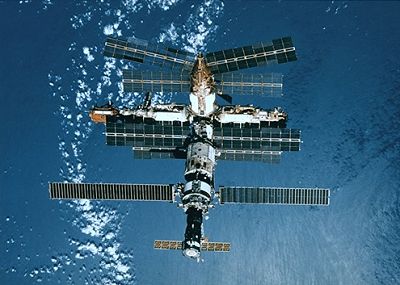Control and Dynamics Laboratory
 The laboratory
includes experimental equipment for the study of space element control including
formation flying. Researchers utilise static attitude hardware-in-the-loop test
stations for the design and verification of attitude and orbital control
systems.
The laboratory
includes experimental equipment for the study of space element control including
formation flying. Researchers utilise static attitude hardware-in-the-loop test
stations for the design and verification of attitude and orbital control
systems.
Spacecraft and particularly space stations such as MIR (right) can have
complex nonlinear dynamics that cause unwanted perturbations and torques.
Researchers are working to develop new control algorithms that can remove
unwanted dynamical behavior in order to enhance performance.
Selected Publications
2006 B. M. Quine. A derivative-free implementation
of the Extended Kalman Filter: Nonlinear State Estimation without Partial
Derivatives, Automatica, 42, 1927-1934.
Abstract: A nonlinear estimation paradigm is developed
to estimate the mean and covariance of a time-evolving state distribution. The
approach represents uncertainty by an ensemble set of state vectors rather than
by the traditional mean and covariance measures, avoiding the need for the
calculation of matrix partial derivatives (Jacobian matrices). The paradigm is
shown to be equivalent to the extended Kalman filter in a limiting case.
Implementation of the new filtering approach is illustrated with a simple
example and a step-by-step description. The paradigm is not significantly more
computationally intensive than traditional filters and proves ideal for the
rapid implementation of complex nonlinear system and observation models.
2002 B. M. Quine, K. Strong, A. Wiacek, D. Wunch, J. A.
Anstey and J. R. Drummond, Scanning the Earth's limb from a high-altitude
balloon: the development and flight of a new balloon based pointing system,
Journal of Atmospheric and Oceanic Technology, 19, pp. 618-632.